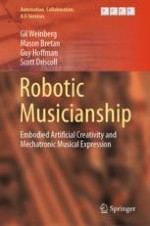This book discusses the principles, methodologies, and challenges of robotic musicianship through an in-depth review of the work conducted at the Georgia Tech Center for Music Technology (GTCMT), where the concept was first developed. Robotic musicianship is a relatively new research field that focuses on the design and development of intelligent music-making machines. The motivation behind the field is to develop robots that not only generate music, but also collaborate with humans by listening and responding in an expressive and creative manner. This combination of human and machine creativity has the potential to surprise and inspire us to play, listen, compose, and think about music in new ways.
The book provides an in-depth view of the robotic platforms designed at the GTCMT Robotic Musicianship Group, including the improvisational robotic percussionists Haile and Shimon, the personal robotic companion Shimi, and a number of wearable robots, such as the Robotic Drumming Prosthesis, The Third Drumming Arm, and the Skywalker Piano Hand. The book discusses numerous research studies based on these platforms in the context of five main principles: Listen like a Human, Play Like a Machine, Be Social, Watch and Learn, and Wear It.
